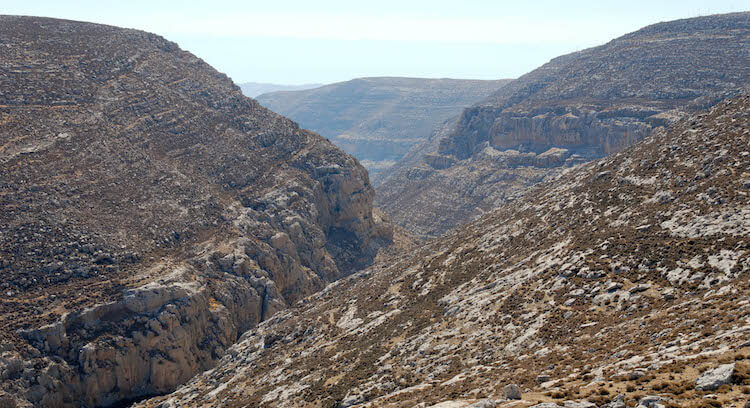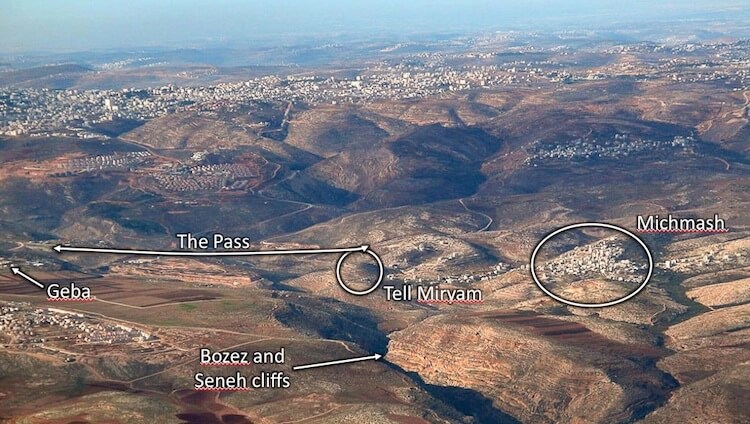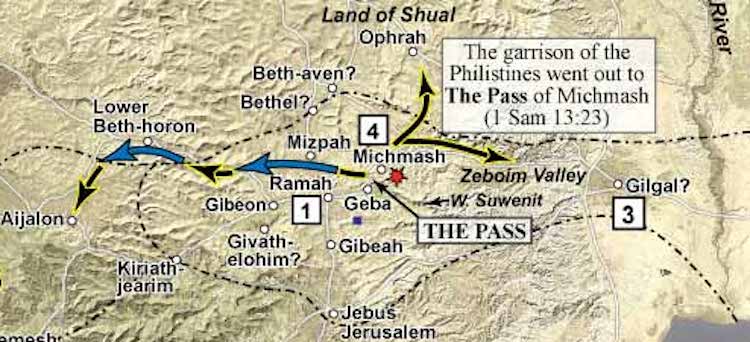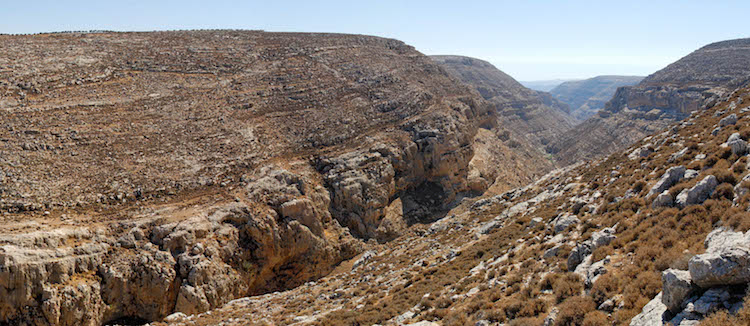When the Bible includes geographical references, they appear as more than throwaway statements. Often they play a vital role in our understanding and application of the Bible.

(Photo: Cliffs near Michmash and Geba. Courtesy of the Pictorial Library of Bible Lands)
For example, geography bears importance as to how Jonathan and his armor-bearer—only two men—could help rout the entire Philistine army.
The geographic descriptions given in 1 Samuel 14:4-5 describe two steep crags on either side of a great ravine separating Geba on the south from Michmash on the north. Here Jonathan and his armor bearer scaled the crags for a surprise attack on the Philistine garrison at Michmash.
Because geography does not change, these natural elements remain for us to easily imagine the story.
As well as its application.
Jonathan—the Original Free Soloing Rock Climber
The modern highway traverses the Wadi Suwenit at an ancient, natural bridge the Scriptures call, “The Pass” (cf. Isaiah 10:29).
The garrison of the Philistines went out to the pass of Michmash. —1 Sam. 13:23
The modern Arab villages of Mukhmas and Jaba preserve the ancient names of Michmash and Geba, and the cliffs between them leave little room for doubt as to the authenticity of the location.

(Photo: Locations of the events of 1 Samuel 14. Courtesy of the Pictorial Library of Bible Lands)
The outnumbered and frightened Hebrews of Saul’s day hid themselves in caves along the Valley of Zeboim.
- It is also by way of this valley (the main route from the Ephraimite hills to the Jordan Valley) that many Hebrews crossed the Jordan River into the land of Gad and Gilead (1 Sam 13:6).
- The Philistines placed a garrison at Michmash where they could both monitor and use this valley road to make periodic raids, maintaining control of the area (1 Sam 13:17-18).

(Map of Michmash battle, courtesy of Satellite Bible Atlas)
When Jonathan determined to climb the ravine to assault the Philistine garrison, instead of traveling along “the Pass” (the normal ascent to Michmash) he attempted something very difficult—and took the Philistines by surprise.
Jonathan said to his armor bearer, ‘Come up after me, for the LORD has given them into the hands of Israel.’ Then Jonathan climbed up on his hands and feet, with his armor bearer behind him; and they fell before Jonathan. —1 Samuel 14:12–13
The names of the steep crags imply the difficulty in scaling them. “Seneh” means “the Thorny One,” and “Bozez” means “the Gleaming One” or “the Miry One.”

(Photo: Cliffs near Michmash and Geba. Courtesy of the Pictorial Library of Bible Lands)
Difficult Geography Highlights the Power of God
The victory came from more than geographical strategy. Ultimately, two men gained victory over twenty soldiers because the Lord was with them (1 Sam 14:6, 12, 23). Jonathan said it this way:
Perhaps the LORD will work for us, for the LORD is not restrained to save by many or by few. —1 Samuel 14:6
Once this area was controlled, God intervened and sent panic throughout the Philistine army. Moreover, in spite of the fact that Israel had no decent weapons of war, the author specifically notes that it was “the LORD [who] delivered Israel that day, and the battle spread beyond Beth-aven” (1 Sam 14:23) and “from Michmash to Aijalon” (1 Sam 14:31). Evidently this is the last time Philistine domination controlled the Central Benjamin Plateau.
Interestingly, God used the victory at Michmash to relocate the Philistine invasion of the Hill Country south via the Elah Valley. This provided the stage upon which God would elevate David as the national hero who would one day become king.
Struggling against impossible odds today? Jonathan’s faith and God’s faithfulness reveal the truth of Jonathan’s statement:
The LORD is not restrained to save by many or by few.
Dive Deeper in Faith With Scripture
Join us for a year-long interactive study of the New Testament & Proverbs that includes maps, photographs, and virtual tour videos that helps bring context and meaning to Scripture. Learn more:
Tell me what you think: What impossible circumstance are you trusting God for today? To leave a comment, just click here.

